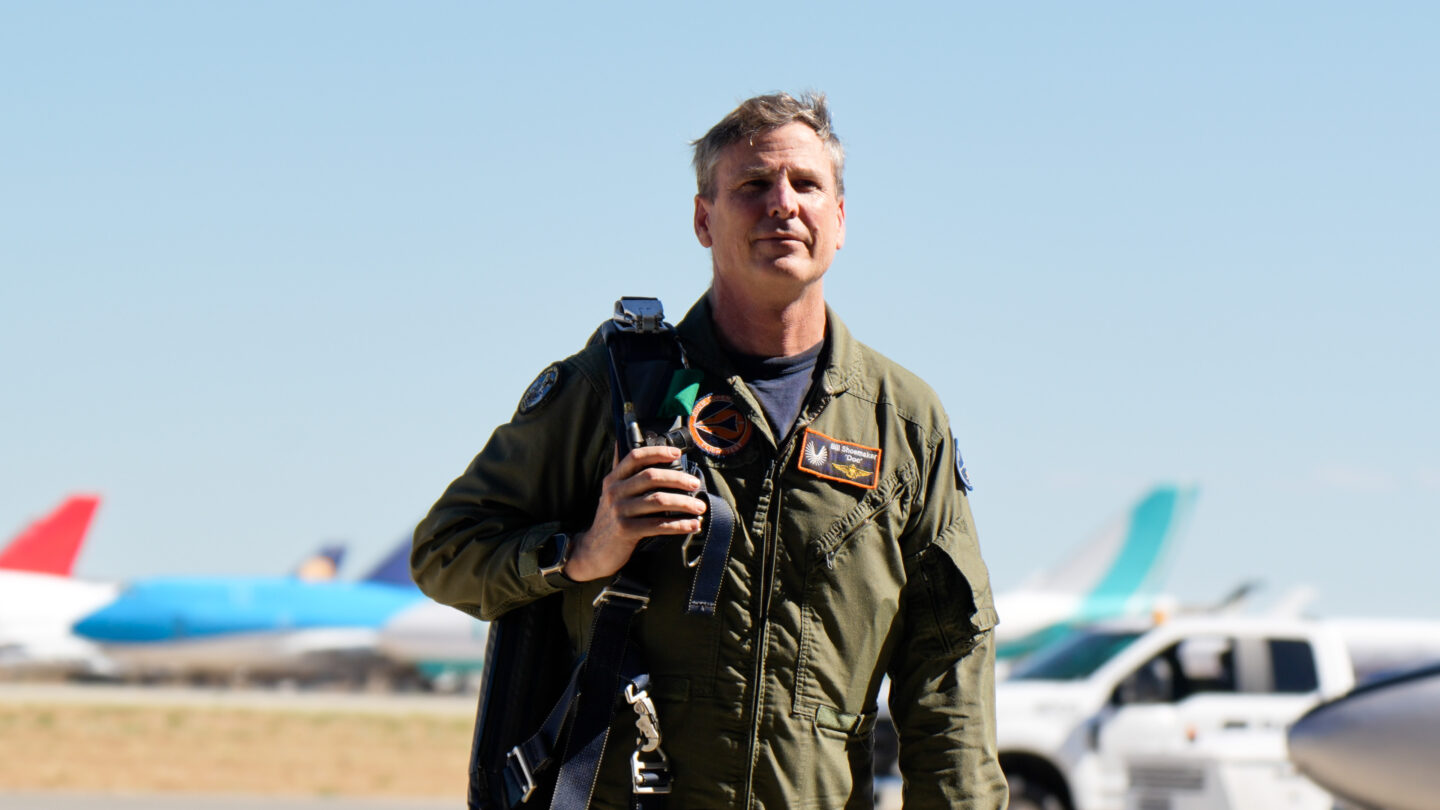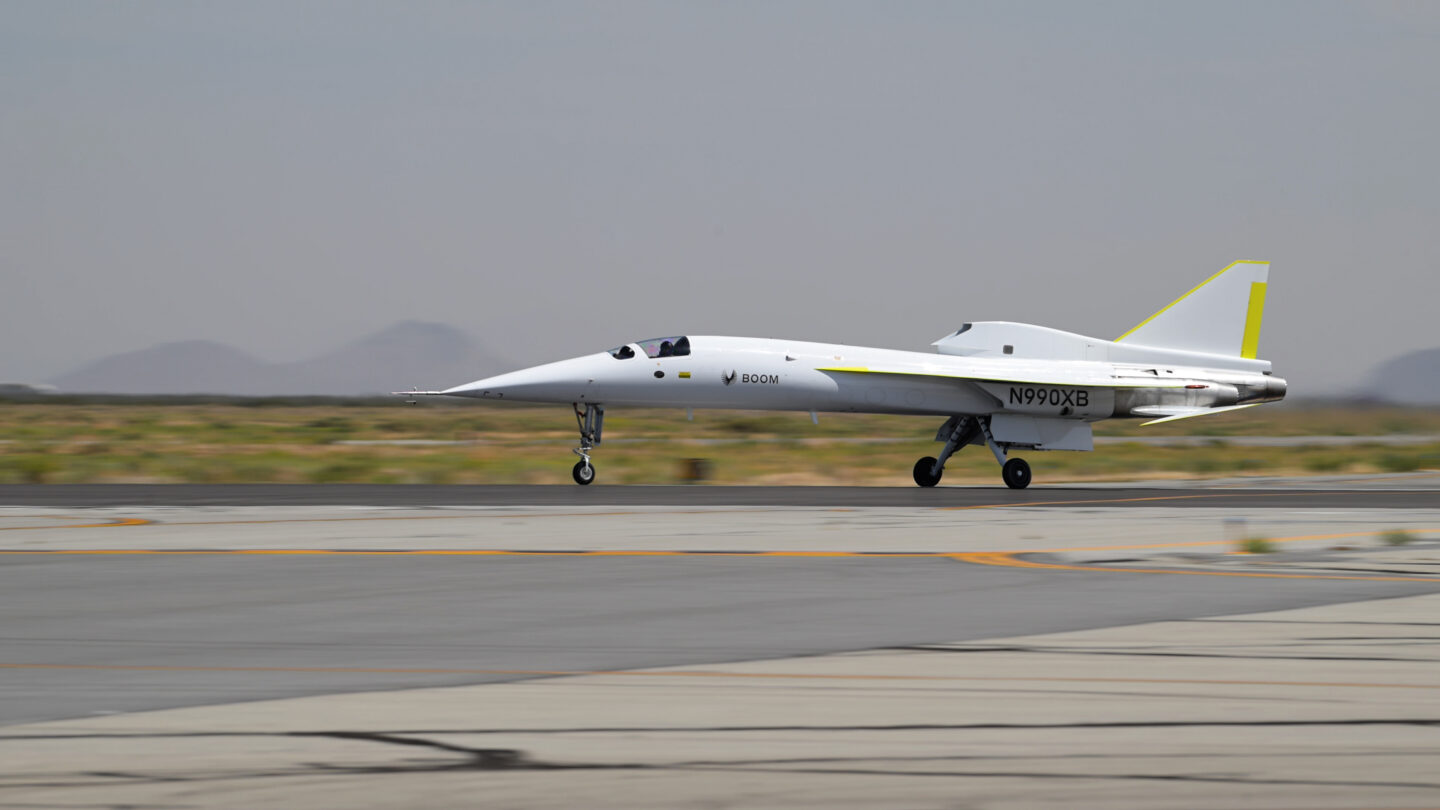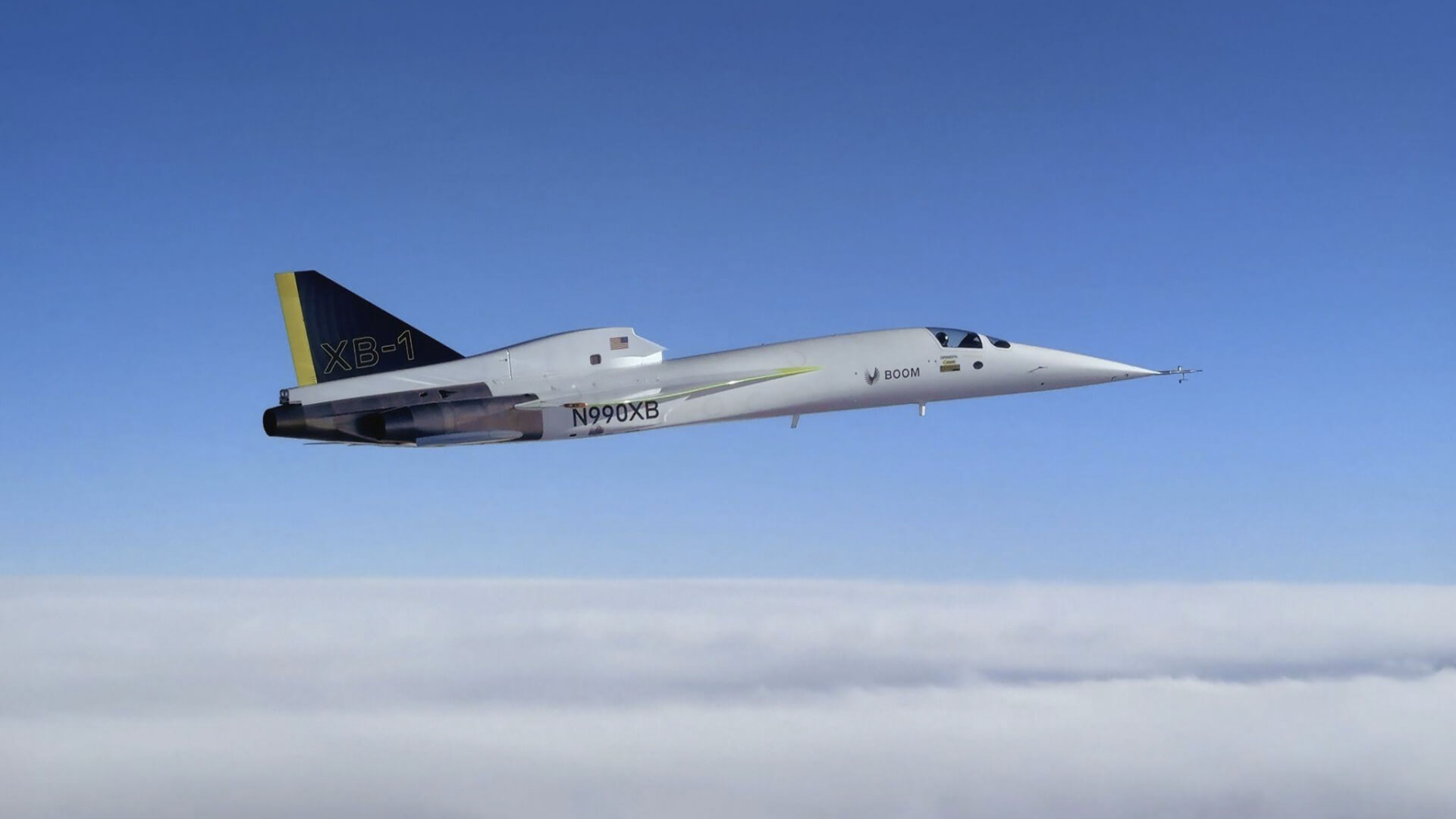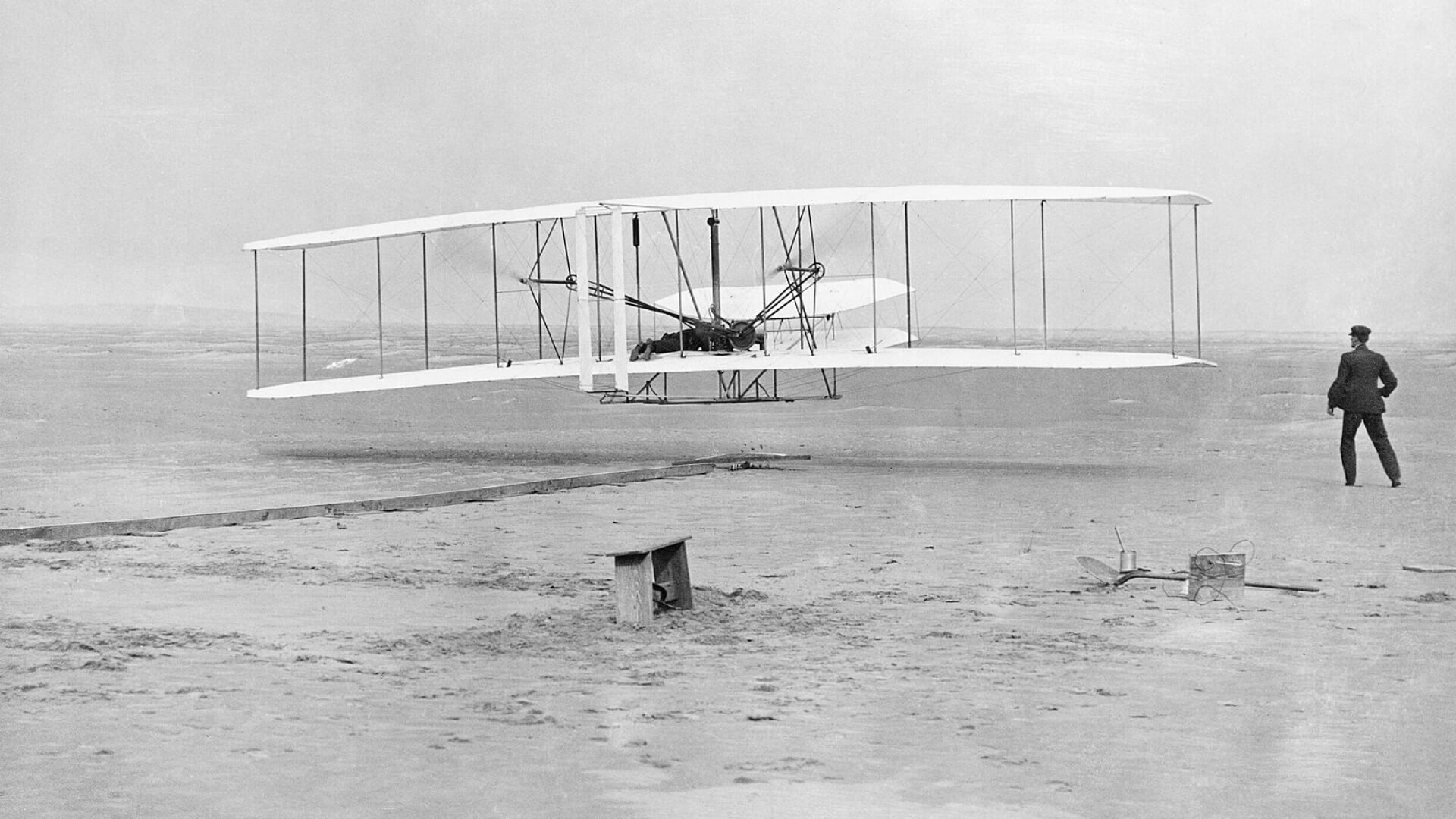Boom’s Chief Test Pilot Bill “Doc” Shoemaker, who joined the company five years ago, has made invaluable contributions to the XB-1 program. For Bill, the road to Boom and XB-1 encompassed graduate study in Aeronautics and Astronautics, military service, and the first flight of several prototype aircraft as a civilian test pilot. A former U.S. naval aviator, he’s a graduate of the United States Naval Test Pilot School who has flown more than 5,000 flight hours in 50 aircraft types, including the first flight of the Block II Super Hornet.
Bill has relocated to Tehachapi, California to be close to XB-1, which is currently located at the Mojave Air & Space Port in preparation for its first flight. Testing activities have included extensive ground and taxi test events, during which the aircraft has already reached 90 knots (104 mph).
Boom’s test pilots, including Bill and Tristan “Geppetto” Brandenburg, have “flown” hundreds of hours in the XB-1 simulator evaluating expected handling qualities, developing test profiles, assessing human factors associated with the design, and training alongside the XB-1 Control Room team. Both Bill and Geppetto maintain flight proficiency in T-38 and F-5 aircraft, the same aircraft they will use to “chase” XB-1 on all test flights. They have also recently flown the F-104, an aircraft that shares many unique flight characteristics with XB-1. Boom has secured letters of authorization from the FAA allowing Bill and Geppetto to act as pilot in command of XB-1 for test flights.
What inspired you to pursue a career in aviation?
As a graduate student in Aeronautics, I had the chance to train toward my private pilot’s license and work alongside a few military test pilots. Every experience I had as a student pilot drove me closer to going “all in” on a military flying career. It was one of those times where I didn’t have the luxury of basing my decision on a complete set of information, but I knew I’d regret letting the opportunity pass me by. When I started my military flying career, the idea of becoming a test pilot was already in my mind.
What are the requirements to become a test pilot and what is required to stay current?
The prerequisites to fly as a test pilot vary from country to country. The FAA does not have specific requirements to become a civilian test pilot (there are, however, requirements to work for the FAA as a test pilot). If someone is qualified to act as pilot in command of an aircraft, they are typically eligible to do flight testing in that aircraft. It often comes down to judgment as to whether their training and experience is appropriate to perform the testing.
Many civilian test pilots in the U.S. are former military pilots who trained at the Air Force Test Pilot School at Edwards Air Force Base in California or the Naval Test Pilot School at Naval Air Station Patuxent River in Maryland. Others are graduates of civilian test pilot schools like the National Test Pilot School in Mojave. There are also many very capable test pilots who do not have formal flight test training.
In preparation for flying XB-1, Geppetto and I have spent many hours studying XB-1’s systems and flying the simulator. We also maintain currency in T-38 and F-5 aircraft. Flying these aircraft allows us to develop chase procedures, practice flight test techniques that we will use in XB-1, and get very familiar with the airspace where we will fly XB-1. Like most prototypes, we expect XB-1 to be relatively demanding, and flying high performance aircraft allows us to keep critical skills sharp.

In your experience, what does it take to make a good test pilot?
The formal training to become a test pilot was in some ways very much what I expected, and in others quite different. I expected it would mean learning how to fly airplanes precisely in order to gather data about them. I didn’t realize how much it would require becoming an effective critic and communicator.
A good test pilot is inherently skeptical, and is always looking at how an airplane’s features could be sculpted to allow pilots to perform its mission more safely and effectively.
A good test pilot is able to not only make reliable observations about an airplane’s behavior, but also relate how that behavior will impact a pilot’s ability to use the airplane to perform a specific mission. An effective test pilot has to understand both the airplane and the mission, and be able to communicate the relationship between the two very clearly.
One of the most valuable experiences during test pilot school was being handed an airplane I was unfamiliar with, and being asked to identify its strengths and weaknesses for a specific mission.
What’s the most memorable moment you’ve had as a test pilot?
Completing the first flight of a new aircraft is always rewarding and memorable. I’ve been lucky enough to have flown several first flights. It’s also rewarding when you discover a deficiency in a design that could have led to a mishap. For example, I discovered a scenario where the F-18 mission computer was providing inaccurate angle of attack information to the Heads Up Display (HUD). If testing hadn’t flushed out this problem, it could have easily killed a colleague down the road.
What was it like the first time you flew supersonic?
There are certain aviation “firsts” that I remember vividly (like the first time landing on an aircraft carrier). I have to confess that I don’t remember the first time I flew supersonic. There are likely two reasons for this. The first is that modern airplanes are carefully designed to make the transitions between subsonic and supersonic flight nearly transparent to the pilot (and passengers). The second is that my first supersonic experience was just incidental to a very busy training mission. As an aspiring fighter pilot, it’s easy to be so immersed in a training scenario that you wouldn’t even realize you went supersonic until reviewing tapes after the flight.
Tell us about your experience at Boom working with the XB-1 team.
I would characterize the team as highly-focused, mutually-supportive, and extremely talented. A complex aircraft program like XB-1 can be like a long rollercoaster ride. The real test of the team is how it comes together to work through the inevitable low points. This team has overcome innumerable obstacles to get where it is today. When the workload has been particularly high for one part of the team, the rest of the team has helped out in any way they can. There are few things more rewarding than being part of a motivated and capable team working toward a really challenging goal. I’m truly proud to be a small part of the XB-1 team, and I’m looking forward to sharing the experience of a successful first flight in the near future.

What are you focused on now?
Along with the entire XB-1 team, we are focused on completing the necessary ground testing to get XB-1 and the flight test team ready for a safe first flight. This includes testing of the aircraft and its systems while at rest as well as in motion during taxi testing. We are also rehearsing the first few flights with the simulator linked to the control room. This gives us the opportunity to refine the profiles we will fly and train for a variety of unexpected scenarios.

What has been the most exciting moment working at Boom and what are you looking forward to?
The most exciting and rewarding moments so far have come during taxi testing. These have been the first times where we’ve really put the aircraft and the team “to the test”. I am looking forward to the moment where XB-1 is airborne and we have the chance to see how the plane really performs. The first moments of flying any new aircraft are definitely exciting. It has been a long but rewarding road to get us to this point where we are nearly ready for takeoff.
XB-1 progress and development
XB-1 leverages 60 years of progress in airplane technologies like carbon fiber composites, advanced avionics, and digitally-optimized aerodynamics. The aircraft features a carbon composite and titanium fuselage. Its ogive (modified delta) wing enables safe operation at takeoff and landing as well as supersonic speeds. The three General Electric J85 engines that power XB-1 produce a combined maximum thrust of 12,300 pounds of force (lbf).
Watch recent taxi tests here and stay tuned for updates as XB-1 continues preparations for first flight.







